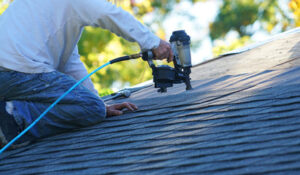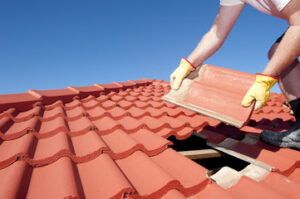Roofing Contractors works to repair or replace the roof of a home. They also install gutters, downspouts and siding. They must comply with New York State law regarding disclosures in home improvement contracts.
Some roofing contractors are storm chasers, which means they follow the weather and knock on doors after a bad storm to offer their services. Their sales presentations can be lengthy and they will usually present the highest priced options first.

A roofing contractor is a person who specializes in installing and repairing roofs. Generally, they work on commercial and residential properties. Some of them have extensive experience in the industry and can offer valuable advice on the best materials to use for a particular property. Some also have the ability to perform other types of home improvement projects, such as siding and window installations. Regardless of the type of project, it is important to choose a contractor who has experience in the industry and is licensed by your state.
Roofing contractors are trained to assess the needs of the building and determine the necessary roofing materials. They also have the skills to handle unexpected problems and ensure that the project is completed on time. Moreover, they can provide a detailed estimate of the cost of the project. This will help the homeowner decide whether to proceed with the work or not.
In addition to installing and repairing roofs, these professionals can also handle other types of home improvement projects, such as painting, siding, and gutter installation. In some cases, they may even be able to help the homeowner navigate through the permitting process. They are also skilled at interpreting architectural blueprints and other building plans.
They know how to install a variety of roofing materials, including asphalt and fiberglass shingles. They can also recommend and install various types of ventilation systems to help with heating and cooling. Roofing contractors often have access to discounted roofing supplies and can offer their clients a wide range of options to meet their budget.
A good roofing contractor can also handle different types of insurance claims and storm damage repair. They can also perform inspections for real estate companies. They typically have a job site support person who is onsite all day to answer questions and interface with the crew. They can also give you a quote right away.
NYC Commercial Roofing Contractors is a full-service roofing company that has been providing roofing solutions to commercial properties across the five boroughs for over 20 years. They are licensed and insured, and their employees take continuing education seriously to stay up to date on code changes. Their services include repairs, replacements, maintenance plans, and inspections.
Licensing
If you are going to hire a roofing contractor, it is important to make sure they have the proper licensing. This will ensure they have the necessary experience and knowledge to complete your roof repair or installation project safely and on time. You should also check with the city or county you live in to see if they have any specific licensing requirements. Licensed roofing contractors are more likely to have insurance and other essential documents such as warranties, permits, and contracts. If you choose an unlicensed roofer, you may risk having your warranty voided by the manufacturer.
In Alaska, a license is required for those who perform construction or repair work on buildings and other structures that are not single-family residences. This includes roofing, roof decks, related sheet metal work, and sealing, water proofing, weatherproofing, or repairing such works. The license can be obtained from the Department of Labor and Industry. Applicants must submit proof of previous roofing experience and pass an exam. Those who fail the exam must wait two years to retake it.
Those who wish to work in Massachusetts must obtain a Home Improvement Contractor (HIC) registration, which includes liability and workers’ compensation coverage. In addition, the HIC registration enables unhappy homeowners to seek restitution from the Home Improvement Guaranty Fund if their contractor is unlicensed and doesn’t do the job properly.
The state of New Mexico requires a license for those who work in the roofing industry. Applicants must have three full years of experience and pass an exam to become a licensed roofing contractor. In addition, they must also provide copies of their W-2s and letters from previous employers to verify their work history. Those who pass the exam are eligible to receive their license from the New Mexico Department of Regulation and Licensing.
In Nebraska, a roofer must register with the State Contractors Board before beginning any work. The registration must include the name of the contractor, business address, and phone number. The roofer must also provide a $15,000 bond before working on a project that is valued at more than $250,000. Those who work on commercial projects are required to have a license for that trade classification.
Insurance
Roofing contractors must have the proper insurance to ensure they can pay for any damages or injuries incurred by third parties due to their work. It also helps a roofer to build a good reputation by showing potential clients that they’re reliable and trustworthy. The type of insurance a roofing contractor needs may vary by state, but general guidelines include liability insurance, commercial auto insurance, builders risk insurance, and workers’ compensation insurance.
Ideally, a roofing company should carry general liability insurance, which protects against claims for bodily injury and property damage. This insurance covers accidents that occur on the job site, such as when a piece of equipment falls off a roof and hits a passerby, or when a worker trips over an object left out in the open. It can also cover legal costs if a client sues over a mistake or miscommunication.
Many roofers choose to include a tools and equipment floater on their general liability policies to make sure that any specialized equipment they use is covered. This is especially important for those who rent or lease their work space. Those who own their workspaces may want to add commercial property insurance to their policy to make sure that their building and inventory is protected against fire, vandalism, or theft.
Workers’ compensation is another important type of insurance for roofers, as it covers employees who get injured on the job. This is particularly important because roofing is a dangerous profession that can result in serious injury. It’s also a requirement in most states for roofing companies to carry this type of insurance.
Roofing contractors can also purchase business owners policy (BOP) coverage, which typically includes general liability and property insurance in one package. This type of policy is a great option for smaller roofing businesses that don’t need the added protection of a workers’ comp policy. Other options that can be included in a BOP include crime insurance, which provides coverage for employee dishonesty or theft, and business interruption/loss of income insurance, which pays for lost revenue if a roofing company is forced to close.
Reputation
When it comes to home improvement projects, you generally get what you pay for. That is why it’s important to find a roofing contractor with a good reputation for quality work and integrity. A reputable contractor will take the time to explain and walk you through your entire roofing job in detail. This will include the scope of work, materials to be used, payment schedule, warranty information and other key details.
It’s also a good idea to find out how long a company has been in business. Companies with longevity and a solid reputation are more likely to be around to support their customers after the job is complete.
A reliable roofing contractor will be happy to provide you with a list of references that you can contact. These references will be able to talk to you about their experiences with the contractor and can help you determine whether or not they are a good fit for your project.
You should always check the Better Business Bureau and local chamber of commerce to see if any complaints have been filed against a roofing contractor. You should also ask for a written estimate from each contractor you are considering hiring. This will allow you to compare apples to apples and avoid any surprises down the road. Be wary of any contractors that refuse to give you a written estimate or only offer vague or cookie cutter contracts.
There are many scam artists out there trying to capitalize on the current insurance climate. These are often called storm chasers and they will follow major storms across the country knocking on doors and offering to do free inspections of the roof damage. If they can convince homeowners that the damage is significant enough to file an insurance claim, they will then charge the homeowner for premium products and add-ons that are not necessary in order to maximize the payout from their insurance company.
It is also important to note that if you do end up choosing one of these storm chasers, your insurance company will most likely flag this as fraud and you may be subject to additional fees and penalties for making false claims. Always hire a local, established roofing contractor to work on your roof.

